Document Type : Original Research Paper
Authors
1 Ph.D. Student, Department of Geology, Tarbiat Modares University, Tehran, Iran
2 Associate Professor, Department of Geology, Tarbiat Modares University, Tehran, Iran
3 Associate Professor, Research institute for Earth Science, Geological Survey of Iran, Tehran, Iran
Abstract
In this study, brittle deformation in Takab complex is discussed. Deformation in the Takab area has been controlled by two sets of major faults. The first set is characterized by NNW-SSE trending steeply-dipping dextral strike-slip faults with reverse component. The second set includes WNW-ESE trending moderately-dipping reverse faults which have been obviously displaced by the first set. The basement metamorphic rocks are exposed in the hangingwall of the faults indicating thick-skinned type of deformation and exhumation in the area. The major strike-slip reverse faults have resulted in dextral inclined transpression in the Takab complex area. Fault-related folds in hangingwall and footwall of the faults especially in the Cenozoic sediments indicate young activity and uplift in the area. Development of normal faults and local folds, as well asthe occurrence of earthquakes in the area imply that it is tectonically active. Structural analysis in this area reveal that the major steeply-dipping strike-slip reverse faults have controlled deformation and changedthe homogeneous strain to partitioned strain.Deformation of Cenozoic rocks overlying the basement metamorphic rocks indicate a dextral inclined transpression. Deformation in the younger sedimentary cover (Cenozoic sediments) is related to thick-skinned deformation in the basement metamorphic rocks.
Keywords

